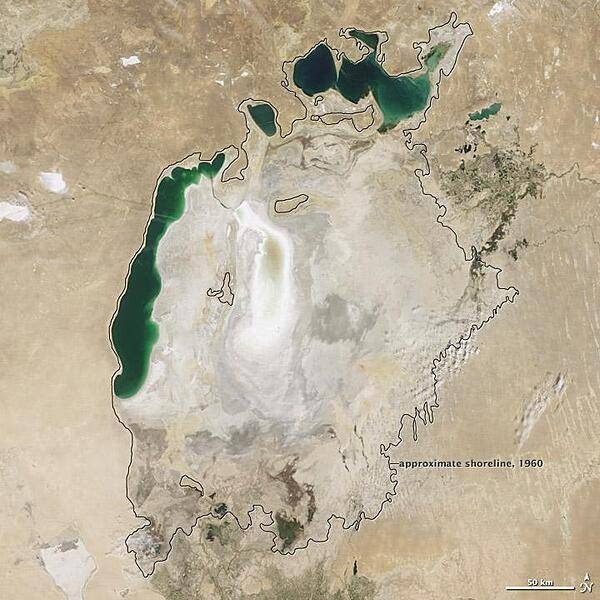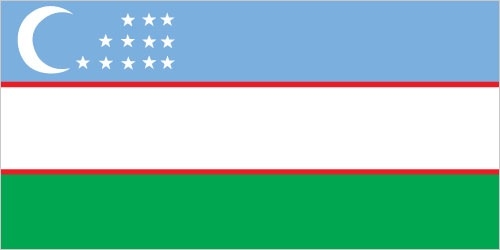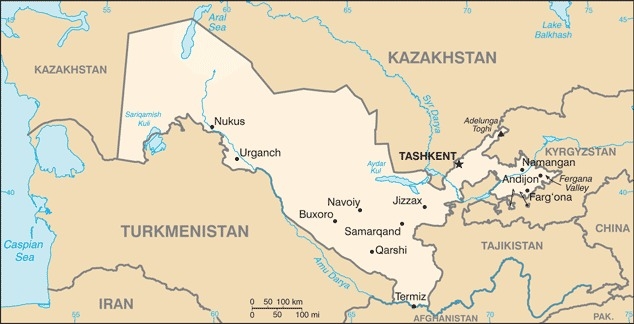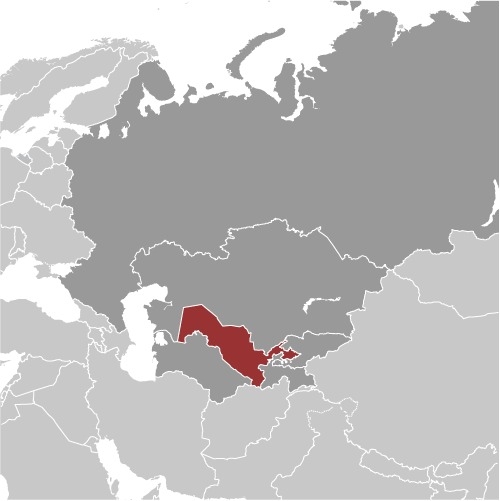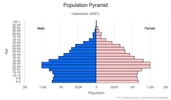Uzbekistan
Introduction
Background
Uzbekistan is the geographic and population center of Central Asia. The country has a diverse economy and a relatively young population. Russia conquered and united the disparate territories of present-day Uzbekistan in the late 19th century. Stiff resistance to the Red Army after the Bolshevik Revolution was eventually suppressed and a socialist republic established in 1924. During the Soviet era, intensive production of "white gold" (cotton) and grain led to the overuse of agrochemicals and the depletion of water supplies, leaving the land degraded and the Aral Sea and certain rivers half-dry. Independent since the dissolution of the USSR in 1991, the country has diversified agricultural production while developing its mineral and petroleum export capacity and increasing its manufacturing base, although cotton remains a major part of its economy. Uzbekistan’s first president, Islom KARIMOV, led Uzbekistan for 25 years until his death in September 2016. His successor, former Prime Minister Shavkat MIRZIYOYEV, has improved relations with Uzbekistan’s neighbors and introduced wide-ranging economic, judicial, and social reforms. MIRZIYOYEV was reelected in October 2021 with 80% of the vote.
Visit the Definitions and Notes page to view a description of each topic.
Geography
Location
Central Asia, north of Turkmenistan, south of Kazakhstan
Geographic coordinates
41 00 N, 64 00 E
Map references
Asia
Land boundaries
total: 6,893 km
border countries (5): Afghanistan 144 km, Kazakhstan 2330 km, Kyrgyzstan 1314 km, Tajikistan 1312 km, Turkmenistan 1793 km
Coastline
0 km (doubly landlocked); note - Uzbekistan includes the southern portion of the Aral Sea with a 420 km shoreline
Maritime claims
none (doubly landlocked)
Climate
mostly mid-latitude desert, long, hot summers, mild winters; semiarid grassland in east
Terrain
mostly flat-to-rolling sandy desert with dunes; broad, flat intensely irrigated river valleys along course of Amu Darya, Syr Darya (Sirdaryo), and Zarafshon; Fergana Valley in east surrounded by mountainous Tajikistan and Kyrgyzstan; shrinking Aral Sea in west
Elevation
highest point: Adelunga Toghi 4,301 m
lowest point: Sariqamish Kuli -12 m
Natural resources
natural gas, petroleum, coal, gold, uranium, silver, copper, lead and zinc, tungsten, molybdenum
Land use
agricultural land: 62.6% (2018 est.)
arable land: 10.1% (2018 est.)
permanent crops: 0.8% (2018 est.)
permanent pasture: 51.7% (2018 est.)
forest: 7.7% (2018 est.)
other: 29.7% (2018 est.)
Irrigated land
42,150 sq km (2012)
Major lakes (area sq km)
Fresh water lake(s): Aral Sea (shared with Kazakhstan) - largely dried up
Major rivers (by length in km)
Syr Darya (shared with Kyrgyzstan [s], Tajikistan, and Kazakhstan [m]) - 3,078 km; Amu Darya river mouth (shared with Tajikistan [s], Afghanistan, and Turkmenistan) - 2,620 km
note – [s] after country name indicates river source; [m] after country name indicates river mouth
Major watersheds (area sq km)
Internal (endorheic basin) drainage: (Aral Sea basin) Amu Darya (534,739 sq km), Syr Darya (782,617 sq km)
Population distribution
most of the population is concentrated in the fertile Fergana Valley in the easternmost arm of the country; the south has significant clusters of people, while the central and western deserts are sparsely populated
Natural hazards
earthquakes; floods; landslides or mudslides; avalanches; droughts
Geography - note
along with Liechtenstein, one of the only two doubly landlocked countries in the world
People and Society
Nationality
noun: Uzbekistani
adjective: Uzbekistani
Ethnic groups
Uzbek 83.8%, Tajik 4.8%, Kazakh 2.5%, Russian 2.3%, Karakalpak 2.2%, Tatar 1.5%, other 4.4% (2017 est.)
Languages
Uzbek (official) 74.3%, Russian 14.2%, Tajik 4.4%, other 7.1%
major-language sample(s):
Jahon faktlari kitobi, asosiy ma'lumotlar uchun zaruriy manba. (Uzbek)
The World Factbook, the indispensable source for basic information.
note: in the autonomous Karakalpakstan Republic, both the Karakalpak language and Uzbek have official status
Religions
Muslim 88% (mostly Sunni), Eastern Orthodox 9%, other 3%
Age structure
0-14 years: 23.19% (male 3,631,693/female 3,456,750)
15-24 years: 16.63% (male 2,601,803/female 2,481,826)
25-54 years: 45.68% (male 6,955,260/female 7,006,172)
55-64 years: 8.63% (male 1,245,035/female 1,392,263)
65 years and over: 5.87% (male 768,769/female 1,025,840) (2020 est.)
Dependency ratios
total dependency ratio: 50.6
youth dependency ratio: 43.4
elderly dependency ratio: 7.2
potential support ratio: 13.9 (2020 est.)
Median age
total: 30.1 years
male: 29.4 years
female: 30.7 years (2020 est.)
Population distribution
most of the population is concentrated in the fertile Fergana Valley in the easternmost arm of the country; the south has significant clusters of people, while the central and western deserts are sparsely populated
Urbanization
urban population: 50.4% of total population (2021)
rate of urbanization: 1.25% annual rate of change (2020-25 est.)
Major urban areas - population
2.545 million TASHKENT (capital) (2021)
Sex ratio
at birth: 1.06 male(s)/female
0-14 years: 1.05 male(s)/female
15-24 years: 1.05 male(s)/female
25-54 years: 0.99 male(s)/female
55-64 years: 0.89 male(s)/female
65 years and over: 0.75 male(s)/female
total population: 0.99 male(s)/female (2020 est.)
Mother's mean age at first birth
23.7 years (2019 est.)
Maternal mortality ratio
29 deaths/100,000 live births (2017 est.)
country comparison to the world: 114Infant mortality rate
total: 19.42 deaths/1,000 live births
male: 23.13 deaths/1,000 live births
female: 15.49 deaths/1,000 live births (2021 est.)
Life expectancy at birth
total population: 75.03 years
male: 71.98 years
female: 78.25 years (2021 est.)
Drinking water source
improved: urban: 100% of population
rural: 96.1% of population
total: 97.8% of population
unimproved: urban: 0% of population
rural: 3.9% of population
total: 2.2% of population (2017 est.)
Current Health Expenditure
5.3% (2018)
Physicians density
2.37 physicians/1,000 population (2014)
Hospital bed density
4 beds/1,000 population (2014)
Sanitation facility access
improved: urban: 100% of population
rural: 100% of population
total: 100% of population
unimproved: urban: 0% of population
rural: 0% of population
total: 0% of population (2017 est.)
HIV/AIDS - deaths
<1,000 (2020 est.)
Literacy
definition: age 15 and over can read and write
total population: 100%
male: 100%
female: 100% (2019)
School life expectancy (primary to tertiary education)
total: 12 years
male: 13 years
female: 12 years (2019)
Environment
Environment - current issues
shrinkage of the Aral Sea has resulted in growing concentrations of chemical pesticides and natural salts; these substances are then blown from the increasingly exposed lake bed and contribute to desertification and respiratory health problems; water pollution from industrial wastes and the heavy use of fertilizers and pesticides is the cause of many human health disorders; increasing soil salination; soil contamination from buried nuclear processing and agricultural chemicals, including DDT
Environment - international agreements
party to: Biodiversity, Climate Change, Climate Change-Kyoto Protocol, Climate Change-Paris Agreement, Comprehensive Nuclear Test Ban, Desertification, Endangered Species, Environmental Modification, Hazardous Wastes, Ozone Layer Protection, Wetlands
signed, but not ratified: none of the selected agreements
Air pollutants
particulate matter emissions: 25.29 micrograms per cubic meter (2016 est.)
carbon dioxide emissions: 91.81 megatons (2016 est.)
methane emissions: 96.16 megatons (2020 est.)
Climate
mostly mid-latitude desert, long, hot summers, mild winters; semiarid grassland in east
Land use
agricultural land: 62.6% (2018 est.)
arable land: 10.1% (2018 est.)
permanent crops: 0.8% (2018 est.)
permanent pasture: 51.7% (2018 est.)
forest: 7.7% (2018 est.)
other: 29.7% (2018 est.)
Urbanization
urban population: 50.4% of total population (2021)
rate of urbanization: 1.25% annual rate of change (2020-25 est.)
Revenue from forest resources
forest revenues: 0% of GDP (2018 est.)
country comparison to the world: 202Waste and recycling
municipal solid waste generated annually: 4 million tons (2016 est.)
Major lakes (area sq km)
Fresh water lake(s): Aral Sea (shared with Kazakhstan) - largely dried up
Major rivers (by length in km)
Syr Darya (shared with Kyrgyzstan [s], Tajikistan, and Kazakhstan [m]) - 3,078 km; Amu Darya river mouth (shared with Tajikistan [s], Afghanistan, and Turkmenistan) - 2,620 km
note – [s] after country name indicates river source; [m] after country name indicates river mouth
Major watersheds (area sq km)
Internal (endorheic basin) drainage: (Aral Sea basin) Amu Darya (534,739 sq km), Syr Darya (782,617 sq km)
Total water withdrawal
municipal: 2.41 billion cubic meters (2017 est.)
industrial: 2.13 billion cubic meters (2017 est.)
agricultural: 54.36 billion cubic meters (2017 est.)
Total renewable water resources
48.87 billion cubic meters (2017 est.)
Government
Country name
conventional long form: Republic of Uzbekistan
conventional short form: Uzbekistan
local long form: O'zbekiston Respublikasi
local short form: O'zbekiston
former: Uzbek Soviet Socialist Republic
etymology: a combination of the Turkic words "uz" (self) and "bek" (master) with the Persian suffix "-stan" (country) to give the meaning "Land of the Free"
Government type
presidential republic; highly authoritarian
Capital
name: Tashkent (Toshkent)
geographic coordinates: 41 19 N, 69 15 E
time difference: UTC+5 (10 hours ahead of Washington, DC, during Standard Time)
etymology: "tash" means "stone" and "kent" means "city" in Turkic languages, so the name simply denotes "stone city"
Administrative divisions
12 provinces (viloyatlar, singular - viloyat), 1 autonomous republic* (avtonom respublikasi), and 1 city** (shahar); Andijon Viloyati, Buxoro Viloyati [Bukhara Province], Farg'ona Viloyati [Fergana Province], Jizzax Viloyati, Namangan Viloyati, Navoiy Viloyati, Qashqadaryo Viloyati (Qarshi), Qoraqalpog'iston Respublikasi [Karakalpakstan Republic]* (Nukus), Samarqand Viloyati [Samarkand Province], Sirdaryo Viloyati (Guliston), Surxondaryo Viloyati (Termiz), Toshkent Shahri [Tashkent City]**, Toshkent Viloyati [Tashkent Province], Xorazm Viloyati (Urganch)
note: administrative divisions have the same names as their administrative centers (exceptions have the administrative center name following in parentheses)
Independence
1 September 1991 (from the Soviet Union)
National holiday
Independence Day, 1 September (1991)
Constitution
history: several previous; latest adopted 8 December 1992
amendments: proposed by the Supreme Assembly or by referendum; passage requires two-thirds majority vote of both houses of the Assembly or passage in a referendum; amended several times, last in 2017
Legal system
civil law system; note - in early 2020, the president signed an amendment to the criminal code, criminal procedure code, and code of administrative responsibility
International law organization participation
has not submitted an ICJ jurisdiction declaration; non-party state to the ICCt
Citizenship
citizenship by birth: no
citizenship by descent only: at least one parent must be a citizen of Uzbekistan
dual citizenship recognized: no
residency requirement for naturalization: 5 years
Suffrage
18 years of age; universal
Executive branch
chief of state: President Shavkat MIRZIYOYEV (interim president from 8 September 2016; formally elected president on 4 December 2016 to succeed longtime President Islom KARIMOV, who died on 2 September 2016; reelected president on 24 October 2021)
head of government: Prime Minister Abdulla ARIPOV (since 14 December 2016)
cabinet: Cabinet of Ministers appointed by the president with most requiring approval of the Senate chamber of the Supreme Assembly (Oliy Majlis)
elections/appointments: president directly elected by absolute majority popular vote in 2 rounds if needed for a 5-year term (eligible for a second term; previously a 5-year term, extended by a 2002 constitutional amendment to 7 years, and reverted to 5 years in 2011); election last held on 24 October 2021 (next to be held in 2026); prime minister nominated by majority party in legislature since 2011, but appointed along with the ministers and deputy ministers by the president
election results:
2021: Shavkat MIRZIYOYEV reelected president in first round; percent of vote - Shavkat MIRZIYOYEV (LDPU) 80.1%, Maqsuda VORISOVA (PDP) 6.7%, Alisher QODIROV (National Revival Democratic Party) 5.5%, Narzullo OBLOMURODOV (Ecological Party) 4.1%, Bahrom ABDUHALIMOV (Adolat) 3.4%
2016: Shavkat MIRZIYOYEV elected president in first round; percent of vote - Shavkat MIRZIYOYEV (LDPU) 88.6%, Hotamjon KETMONOV (PDP) 3.7%, Narimon UMAROV (Adolat) 3.5%, Sarvar OTAMURODOV (National Revival Democratic Party) 2.4%, other 1.8%
Legislative branch
description: bicameral Supreme Assembly or Oliy Majlis consists of:
Senate or Senat (100 seats; 84 members indirectly elected by regional governing councils and 16 appointed by the president; members serve 5-year terms)
Legislative Chamber or Qonunchilik Palatasi (150 seats; members directly elected in single-seat constituencies by absolute majority vote with a second round if needed; members serve 5-year terms)
elections: Senate - last held 16-17 January 2020 (next to be held in 2025)
Legislative Chamber - last held on 22 December 2019 and 5 January 2020 (next to be held in December 2024)
election results: Senate - percent of vote by party - NA; seats by party - NA; composition - men 77, women 23, percent of women 23%
Legislative Chamber - percent of vote by party - NA; seats by party - LDPU 53, National Revival Democratic Party 36, Adolat 24, PDP 22, Ecological Movement 15; composition - men 83, women, 17, percent of women 17%
note: all parties in the Supreme Assembly support President Shavkat MIRZIYOYEV
Judicial branch
highest courts: Supreme Court (consists of 67 judges organized into administrative, civil, criminal, and economic sections); Constitutional Court (consists of 7 judges)
judge selection and term of office: judges of the highest courts nominated by the president and confirmed by the Senate of the Oliy Majlis; judges appointed for initial 5-year term and can be reappointed for subsequent 10-year and lifetime terms
subordinate courts: regional, district, city, and town courts
Political parties and leaders
Ecological Party of Uzbekistan (O'zbekiston Ekologik Partivasi) [Narzullo OBLOMURODOV]
Justice (Adolat) Social Democratic Party of Uzbekistan [Bahrom ABDUHALIMOV]
Liberal Democratic Party of Uzbekistan (O'zbekiston Liberal-Demokratik Partiyasi) or LDPU [Aktam HAITOV]
National Revival Democratic Party of Uzbekistan (O'zbekiston Milliy Tiklanish Demokratik Partiyasi) [Alisher QODIROV]
People's Democratic Party of Uzbekistan (Xalq Demokratik Partiyas) or PDP [Ulugbek Ilyosovich INOYATOV] (formerly Communist Party)
International organization participation
ADB, CICA, CIS, EAEU (observer), EAPC, EBRD, ECO, EEU (observer), FAO, IAEA, IBRD, ICAO, ICC (national committees), ICCt, ICRM, IDA, IDB, IFAD, IFC, IFRCS, ILO, IMF, Interpol, IOC, ISO, ITSO, ITU, MIGA, NAM, OIC, OPCW, OSCE, PFP, SCO, UN, UNCTAD, UNESCO, UNIDO, UNWTO, UPU, WCO, WFTU (NGOs), WHO, WIPO, WMO, WTO (observer)
Diplomatic representation in the US
chief of mission: Ambassador Javlon VAHOBOV (since 29 November 2017)
chancery: 1746 Massachusetts Avenue NW, Washington, DC 20036
telephone: [1] (202) 887-5300
FAX: [1] (202) 293-6804
email address and website:
info.washington@mfa.uz
https://www.uzbekistan.org/
consulate(s) general: New York
Diplomatic representation from the US
chief of mission: Ambassador Daniel ROSENBLUM (since 24 May 2019)
embassy: 3 Moyqorghon, 5th Block, Yunusobod District, 100093 Tashkent
mailing address: 7110 Tashkent Place, Washington DC 20521-7110
telephone: [998] 78-120-5450
FAX: [998] 78-120-6335
email address and website:
ACSTashkent@state.gov
https://uz.usembassy.gov/
Flag description
three equal horizontal bands of blue (top), white, and green separated by red fimbriations with a vertical, white crescent moon (closed side to the hoist) and 12 white, five-pointed stars shifted to the hoist on the top band; blue is the color of the Turkic peoples and of the sky, white signifies peace and the striving for purity in thoughts and deeds, while green represents nature and is the color of Islam; the red stripes are the vital force of all living organisms that links good and pure ideas with the eternal sky and with deeds on earth; the crescent represents Islam and the 12 stars the months and constellations of the Uzbek calendar
National symbol(s)
khumo (mythical bird); national colors: blue, white, red, green
National anthem
name: "O'zbekiston Respublikasining Davlat Madhiyasi" (National Anthem of the Republic of Uzbekistan)
lyrics/music: Abdulla ARIPOV/Mutal BURHANOV
note: adopted 1992; after the fall of the Soviet Union, Uzbekistan kept the music of the anthem from its time as a Soviet Republic but adopted new lyrics
Economy
Economic overview
Uzbekistan is a doubly landlocked country in which 51% of the population lives in urban settlements; the agriculture-rich Fergana Valley, in which Uzbekistan’s eastern borders are situated, has been counted among the most densely populated parts of Central Asia. Since its independence in September 1991, the government has largely maintained its Soviet-style command economy with subsidies and tight controls on production, prices, and access to foreign currency. Despite ongoing efforts to diversify crops, Uzbek agriculture remains largely centered on cotton; Uzbekistan is the world's fifth-largest cotton exporter and seventh-largest producer. Uzbekistan's growth has been driven primarily by state-led investments, and export of natural gas, gold, and cotton provides a significant share of foreign exchange earnings.
Recently, lower global commodity prices and economic slowdowns in neighboring Russia and China have hurt Uzbekistan's trade and investment and worsened its foreign currency shortage. Aware of the need to improve the investment climate, the government is taking incremental steps to reform the business sector and address impediments to foreign investment in the country. Since the death of first President Islam KARIMOV and election of President Shavkat MIRZIYOYEV, emphasis on such initiatives and government efforts to improve the private sector have increased. In the past, Uzbek authorities accused US and other foreign companies operating in Uzbekistan of violating Uzbek laws and have frozen and seized their assets.
As a part of its economic reform efforts, the Uzbek Government is looking to expand opportunities for small and medium enterprises and prioritizes increasing foreign direct investment. In September 2017, the government devalued the official currency rate by almost 50% and announced the loosening of currency restrictions to eliminate the currency black market, increase access to hard currency, and boost investment.
Real GDP (purchasing power parity)
$239.42 billion note: data are in 2017 dollars (2020 est.)
$235.54 billion note: data are in 2017 dollars (2019 est.)
$222.63 billion note: data are in 2017 dollars (2018 est.)
note: data are in 2017 dollars
Real GDP growth rate
5.3% (2017 est.)
7.8% (2016 est.)
7.9% (2015 est.)
Real GDP per capita
$7,000 note: data are in 2017 dollars (2020 est.)
$7,000 note: data are in 2017 dollars (2019 est.)
$6,800 note: data are in 2017 dollars (2018 est.)
note: data are in 2017 dollars
GDP (official exchange rate)
$57.789 billion (2019 est.)
Inflation rate (consumer prices)
12.5% (2017 est.)
8% (2016 est.)
note: official data; based on independent analysis of consumer prices, inflation reached 22% in 2012
Credit ratings
Fitch rating: BB- (2018)
Moody's rating: B1 (2019)
Standard & Poors rating: BB- (2018)
GDP - composition, by sector of origin
agriculture: 17.9% (2017 est.)
industry: 33.7% (2017 est.)
services: 48.5% (2017 est.)
GDP - composition, by end use
household consumption: 59.5% (2017 est.)
government consumption: 16.3% (2017 est.)
investment in fixed capital: 25.3% (2017 est.)
investment in inventories: 3% (2017 est.)
exports of goods and services: 19% (2017 est.)
imports of goods and services: -20% (2017 est.)
Agricultural products
milk, wheat, potatoes, carrots/turnips, cotton, tomatoes, vegetables, grapes, onions, watermelons
Industries
textiles, food processing, machine building, metallurgy, mining, hydrocarbon extraction, chemicals
Labor force - by occupation
agriculture: 25.9%
industry: 13.2%
services: 60.9% (2012 est.)
Unemployment rate
5% (2017 est.)
5.1% (2016 est.)
note: official data; another 20% are underemployed
Population below poverty line
14.1% (2013 est.)
Gini Index coefficient - distribution of family income
36.8 (2003)
44.7 (1998)
Household income or consumption by percentage share
lowest 10%: 2.8%
highest 10%: 29.6% (2003)
Budget
revenues: 15.22 billion (2017 est.)
expenditures: 15.08 billion (2017 est.)
Fiscal year
calendar year
Current account balance
$1.713 billion (2017 est.)
$384 million (2016 est.)
Exports
$14.52 billion note: data are in current year dollars (2020 est.)
$16.99 billion note: data are in current year dollars (2019 est.)
$14.14 billion note: data are in current year dollars (2018 est.)
Exports - partners
Switzerland 19%, United Kingdom 17%, Russia 15%, China 14%, Kazakhstan 9%, Turkey 8%, Kyrgyzstan 5% (2019)
Exports - commodities
gold, natural gas, cotton fibers, copper, ethylene polymers (2019)
Imports
$22.56 billion note: data are in current year dollars (2020 est.)
$26.55 billion note: data are in current year dollars (2019 est.)
$23.44 billion note: data are in current year dollars (2018 est.)
Imports - partners
China 23%, Russia 18%, South Korea 11%, Kazakhstan 9%, Turkey 6%, Germany 5% (2019)
Imports - commodities
cars and vehicle parts, packaged medicines, refined petroleum, aircraft, construction vehicles (2019)
Reserves of foreign exchange and gold
$16 billion (31 December 2017 est.)
$14 billion (31 December 2016 est.)
Debt - external
$16.9 billion (31 December 2017 est.)
$16.76 billion (31 December 2016 est.)
Exchange rates
Uzbekistani soum (UZS) per US dollar -
3,906.1 (2017 est.)
2,966.6 (2016 est.)
2,966.6 (2015 est.)
2,569.6 (2014 est.)
2,311.4 (2013 est.)
Energy
Electricity access
electrification - total population: 100% (2020)
Electricity - installed generating capacity
12.96 million kW (2016 est.)
country comparison to the world: 54Electricity - from fossil fuels
86% of total installed capacity (2016 est.)
country comparison to the world: 69Electricity - from nuclear fuels
0% of total installed capacity (2017 est.)
country comparison to the world: 206Electricity - from hydroelectric plants
14% of total installed capacity (2017 est.)
country comparison to the world: 109Electricity - from other renewable sources
0% of total installed capacity (2017 est.)
country comparison to the world: 212Refined petroleum products - production
61,740 bbl/day (2015 est.)
country comparison to the world: 78Refined petroleum products - consumption
60,000 bbl/day (2016 est.)
country comparison to the world: 95Natural gas - proved reserves
1.841 trillion cu m (1 January 2018 est.)
country comparison to the world: 18Communications
Telephones - fixed lines
total subscriptions: 3,550,069 (2020)
subscriptions per 100 inhabitants: 10.61 (2020 est.)
Telephones - mobile cellular
total subscriptions: 33.387 million (2020)
subscriptions per 100 inhabitants: 99.75 (2020 est.)
Telecommunication systems
general assessment: land-locked, authoritarian state with government grip on ICT technology and no integrated plan; government plans to develop infrastructure to improve geographical disparities in service; increased investment in infrastructure, with aims of expanding subscriber base and rising revenue; some villages have no connectivity, and 70% have 2G with development of 3G and 4G; free WiFi spots across country to boost tourism; Russian operator invested in joint venture on mobile services; government in discussion with Huawei on additional ventures; digital exchanges in large cities and some rural areas; fixed-line is underdeveloped due to preeminence of mobile market; introduction of prepaid Internet has contributed to home Internet usage; consumers largely reliant on terrestrial links and VSAT networks; media controlled by state; importer of broadcasting equipment from China (2020)
domestic: fixed-line 11 per 100 person and mobile-cellular 101 per 100; the state-owned telecommunications company, Uzbek Telecom, owner of the fixed-line telecommunications system, has used loans from the Japanese government and the China Development Bank to upgrade fixed-line services including conversion to digital exchanges; mobile-cellular services are provided by 2 private and 3 state-owned operators with a total subscriber base of 22.8 million as of January 2018 (2019)
international: country code - 998; linked by fiber-optic cable or microwave radio relay with CIS member states and to other countries by leased connection via the Moscow international gateway switch; the country also has a link to the Trans-Asia-Europe (TAE) fiber-optic cable; Uzbekistan has supported the national fiber-optic backbone project of Afghanistan since 2008
note: the COVID-19 pandemic continues to have a significant impact on production and supply chains globally; since 2020, some aspects of the telecom sector have experienced downturn, particularly in mobile device production; many network operators delayed upgrades to infrastructure; progress towards 5G implementation was postponed or slowed in some countries; consumer spending on telecom services and devices was affected by large-scale job losses and the consequent restriction on disposable incomes; the crucial nature of telecom services as a tool for work and school from home became evident, and received some support from governments
Broadcast media
the government controls media; 17 state-owned broadcasters - 13 TV and 4 radio - provide service to virtually the entire country; about 20 privately owned TV stations, overseen by local officials, broadcast to local markets; privately owned TV stations are required to lease transmitters from the government-owned Republic TV and Radio Industry Corporation; in 2019, the Uzbek Agency for Press and Information was reorganized into the Agency of Information and Mass Communications and became part of the Uzbek Presidential Administration with recent appointment of the Uzbek President's elder daughter as it deputy director (2019)
Internet users
total: 18.6 million (2021 est.)
percent of population: 52.31% (2019 est.)
Broadband - fixed subscriptions
total: 4,820,009 (2020)
subscriptions per 100 inhabitants: 14.4 (2020 est.)
Transportation
National air transport system
number of registered air carriers: 2 (2020)
inventory of registered aircraft operated by air carriers: 34
annual passenger traffic on registered air carriers: 3,056,558 (2018)
annual freight traffic on registered air carriers: 89.43 million mt-km (2018)
Airports - with paved runways
total: 33
over 3,047 m: 6
2,438 to 3,047 m: 13
1,524 to 2,437 m: 6
914 to 1,523 m: 4
under 914 m: 4 (2013)
Airports - with unpaved runways
total: 20
2,438 to 3,047 m: 2
under 914 m: 18 (2013)
Pipelines
13,700 km gas, 944 km oil (2016)
Railways
total: 4,642 km (2018)
broad gauge: 4,642 km 1.520-m gauge (1,684 km electrified) (2018)
Roadways
total: 86,496 km (2000)
paved: 75,511 km (2000)
unpaved: 10,985 km (2000)
Ports and terminals
river port(s): Termiz (Amu Darya)
Military and Security
Military and security forces
Armed Forces of Uzbekistan: Army, Air and Air Defense Forces; National Guard; Ministry of Interior: Internal Security Troops, Border Guards, Security Service (2021)
note - the National Guard, also under the Ministry of Defense, ensures public order and security of diplomatic missions, radio and television broadcasting, and other state entities
Military expenditures
1.2% of GDP (2020 est.)
1.2% of GDP (2019 est.)
4% of GDP (2018 est.)
Military and security service personnel strengths
information varies; approximately 50-60,000 total active troops (2021)
Military equipment inventories and acquisitions
the Uzbek Armed Forces use mainly Soviet-era equipment, although since 2010 they have received weapons and aircraft from a variety of sources, including China, France, Russia, Spain, Turkey, and the US (2021)
Military service age and obligation
18-27 years of age for compulsory military service; 1-year conscript service obligation for males (conscripts have the option of paying for a shorter service of one month while remaining in the reserves until the age of 27); Uzbek citizens who have completed their service terms in the armed forces have privileges in employment and admission to higher educational institutions (2021)
Military - note
the Uzbek armed forces were established in January 1992, following the dissolution of the Soviet Union, when the newly-established Ministry for Defense Affairs assumed jurisdiction over all former Soviet ground, air, and air defense units, formations, and installations then deployed on its soil; the building hosting the headquarters for the ex-Soviet Turkestan Military District became the headquarters for the Uzbek armed forces; all former Soviet troops departed Uzbekistan by 1995; as of 2021, Uzbekistan continued to maintain bilateral defense ties with Russia based on a 2005 mutual security agreement
as of 2021, Uzbekistan was not part of the Russian-sponsored Collective Security Treaty Organization (CSTO) that is comprised of former Soviet Republics; Uzbekistan joined in the 1990s but withdrew in 1999; it returned in 2006 but left again in 2012
Terrorism
Terrorist group(s)
Islamic Jihad Union; Islamic Movement of Uzbekistan
note: details about the history, aims, leadership, organization, areas of operation, tactics, targets, weapons, size, and sources of support of the group(s) appear(s) in Appendix-T
Transnational Issues
Disputes - international
prolonged drought and cotton monoculture in Uzbekistan and Turkmenistan created water-sharing difficulties for Amu Darya river states; field demarcation of the boundaries with Kazakhstan commenced in 2004; border delimitation of 130 km of border with Kyrgyzstan is hampered by serious disputes around enclaves and other areas
Refugees and internally displaced persons
stateless persons: 69,791 (2020)
Trafficking in persons
current situation: Uzbekistan is a source country for men, women, and children subjected to forced labor and women and children subjected to sex trafficking; adults are victims of government-organized forced labor during Uzbekistan’s annual cotton harvest; local officials in some instances force teachers, students (including children), private businesses employees, and others to work in construction and other forms of non-cotton agriculture and to clean parks, streets, and buildings; traffickers exploit Uzbek women and children in sex trafficking in the Middle East, Eurasia, and Asia, and internally in brothels, clubs, and private residences; traffickers subject Uzbek men, and to a lesser extent women, to forced labor in Kazakhstan, Russia, Moldova, Turkey, and in other Asian, Middle Eastern, and European countries in the construction, oil and gas, agricultural, retail, and food sectors
tier rating: Tier 2 Watch List — Uzbekistan does not fully comply with the minimum standards for the elimination of trafficking but is making significant efforts to do so; government efforts included addressing the use of forced adult labor during the cotton harvest by increasing pay to laborers and improving working conditions for voluntary workers and ceasing the forced use of students, teachers, and health care workers; third-party monitors were allowed access to the harvest to view changes; the government created a National Commission on Trafficking chaired by the regional governor in every area of the country; however, reports continued of corrupt officials requiring public sector employees to pick cotton or pay for a replacement worker with extorted penalties paid to them; fewer cases of traffickers were investigated and prosecuted, fewer victims of trafficking were identified, and fewer convictions carried a prison sentence; authorities conducted no investigations against corrupt officials extorting money during the cotton harvest (2020)
Illicit drugs
transit country for Afghan opium and heroin destined for Russia and the European Union; also transit country for hashish, cannabis products, New Psychoactive Substances (NPS), and synthetic drugs; cannabis and poppy are cultivated in small amounts for personal use and local sale
